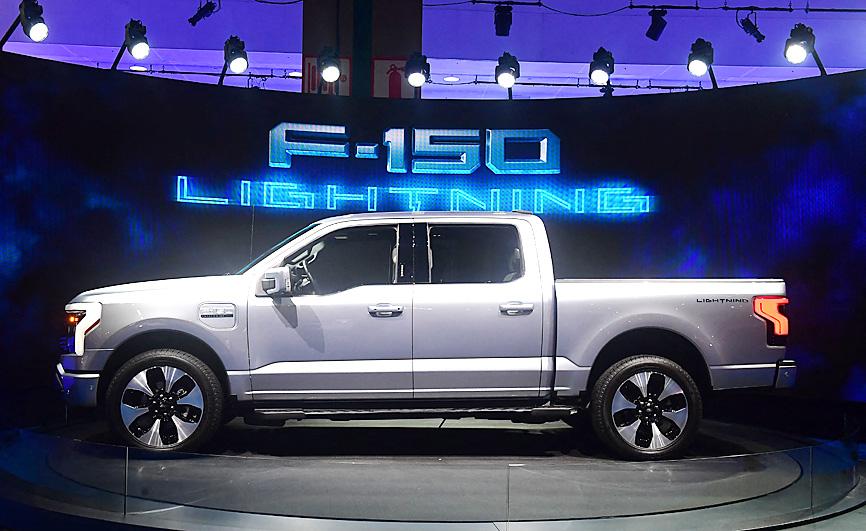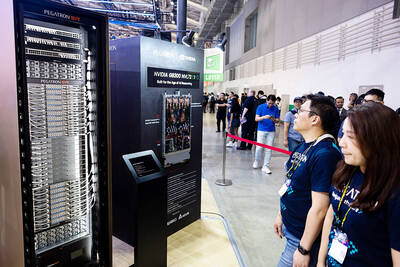Ford Motor Co chief executive officer Jim Farley faced intense investor pressure to spin off his company’s electric vehicle (EV) business to unlock the rich values awarded to pure-play EV outfits like Tesla Inc. Instead, he decided to squeeze more out of Ford’s 118-year-old combustion engine business.
The historic reorganization Farley announced on Wednesday cleaves his company’s automaking in two, creating a “Model e” unit to scale up EV offerings and “Ford Blue” to focus on traditional internal combustion engine (ICE) vehicles.
The radical restructuring relies on gas burners to fund Ford’s EV ambitions, which are vast. The automaker now says it would build 2 million EVs a year by 2026, a giant leap from the 27,140 battery-powered Mustang Mach-Es it sold last year. It raised its margin goal for earnings before interest and taxes to 10 percent, from a previous target of 8 percent.

Photo: AFP
To get there, Ford is planning to boost profit from its traditional business — selling fossil-fuel-powered F-150 pickups and Bronco sports utility vehicles — by slashing costs in its legacy operations, which could include layoffs, Farley said.
Rather than seek greater access to capital markets through the clean break a spinoff could bring, Farley said Ford would transform its traditional internal combustion business into “a profit and cash engine for the entire enterprise.”
“The most important thing is our core ICE automotive business,” Farley said in an interview with Bloomberg TV. “It needs to be a lot more profitable. We think we’re going to have to take about US$3 billion out of our structural cost to make that business fully competitive.”
Farley, 59, has taken a long journey in his short 17 months as Ford’s chief executive officer to reach this point. His moves to accelerate Ford’s plug-in plans reversed a six-year slump in the stock, which is up more than 170 percent since he took over — including an 8.4 percent gain on Wednesday.
The performance has given him personal cachet to try new things, such as radically reshaping the company Henry Ford founded in 1903.
Farley’s family has been part of that story. He joined Ford in 2007 after a successful career at Toyota Motor Corp, where he rose to run the Lexus luxury division, but going to Ford was in some ways a homecoming. Farley’s grandfather, Emmet Tracy, was employee No. 389 when he was hired into Ford’s Model T factory in 1914.
Farley raised the automaker’s wager on EVs months after taking over as chief executive officer.
To push the boundaries of what had been considered possible at the old company, Farley in September last year poached Doug Field from running Apple Inc’s secretive auto project. Prior to Apple, Field had been Tesla’s chief engineer and the man behind its top-selling Model 3 sedan. Farley put him to work reshaping the company.
Together they exhaustively examined ways to spin off either the EV business, the internal combustion business or both to find a way to get Ford — or some of its separated parts — to be viewed in the same league as Tesla, the world’s most valuable automaker.
“We certainly looked at a spinoff,” Farley said at a news conference. “But No. 1, we have enough capital. We can fund this ourselves.”
Farley said he did not want to separate his nascent EV business from the industrial expertise of Ford’s century-old combustion engine business, which can efficiently spit out millions of models a year.
“The new start-ups would love to have the industrial know-how of this company — why would we spin out Model e and risk that?” Farley said. “We looked at it carefully and this leverage is really the key point.”
Another challenge Farley would have faced in the spinoff scenario would be winning over the founding Ford family, which continues to control the company through a special class of stock. The family, which holds three seats on the board led by executive chair Bill Ford, is loath to lose influence of a company they have held sway over for five generations.
Keeping the changes internal assuages those concerns, but it also creates a complex corporate construction where one quasi-independent unit — Ford Blue — funds another quasi-independent unit — Model e. Each operation is to have its own profit and loss statement starting next year. Farley contends that each semi-independent unit would flourish with more time to home in on the particular task at hand.
“We can’t compete with the very best of the ICE or the BEV [battery electric vehicle] world by working on battery-electrics from 9 to 10 in the morning,” Farley said in the interview. “We have to be focused.”
Farley also is boosting Ford’s bet again on EVs, adding another US$20 billion to take the total tab up to US$50 billion by 2026, as Bloomberg previously reported.
That cash would come from the legacy business, where the F-Series pickup alone generates US$42 billion a year in revenue, making it larger by that measure than McDonald’s Corp, Coca-Cola Co or Starbucks Corp.
“We just raised our volume essentially by a million units” to 2 million EVs a year, Farley said. “With that comes lots of capital” for battery plants, new vehicles and platforms, tooling and raw material for batteries, he said.
Those demands meant that Ford needed to keep its “profit engine” traditional business yoked to the upstart EV operations.
So far investors like what they see, driving shares up on Wednesday by the most since Jan. 4.
“We are positive on the change as we do believe it better aligns internal Ford stakeholders to drive towards being more competitive,” RBC Capital Markets analyst Joe Spak said.

AI TALENT: No financial details were released about the deal, in which top Groq executives, including its CEO, would join Nvidia to help advance the technology Nvidia Corp has agreed to a licensing deal with artificial intelligence (AI) start-up Groq, furthering its investments in companies connected to the AI boom and gaining the right to add a new type of technology to its products. The world’s largest publicly traded company has paid for the right to use Groq’s technology and is to integrate its chip design into future products. Some of the start-up’s executives are leaving to join Nvidia to help with that effort, the companies said. Groq would continue as an independent company with a new chief executive, it said on Wednesday in a post on its Web

RESPONSE: The Japanese Ministry of Finance might have to intervene in the currency markets should the yen keep weakening toward the 160 level against the US dollar Japan’s chief currency official yesterday sent a warning on recent foreign exchange moves, after the yen weakened against the US dollar following Friday last week’s Bank of Japan (BOJ) decision. “We’re seeing one-directional, sudden moves especially after last week’s monetary policy meeting, so I’m deeply concerned,” Japanese Vice Finance Minister for International Affairs Atsushi Mimura told reporters. “We’d like to take appropriate responses against excessive moves.” The central bank on Friday raised its benchmark interest rate to the highest in 30 years, but Bank of Japan Governor Kazuo Ueda chose to keep his options open rather than bolster the yen,

Global server shipments are expected to surge to 15 million units next year, from 4 million units this year, with artificial intelligence (AI) servers accounting for about 30 percent, driven by massive capital spending by major cloud service providers, the Market Intelligence and Consulting Institute (MIC) said on Thursday last week. Major cloud service providers — including Google’s parent company Alphabet Inc, Microsoft Corp, Amazon.com Inc and Meta Platforms Inc — are projected to budget US$450 million for capital expenditure next year, up from US$400 million this year, MIC ICT [information and communications technology] Industry Research Center director Edward Lin

Even as the US is embarked on a bitter rivalry with China over the deployment of artificial intelligence (AI), Chinese technology is quietly making inroads into the US market. Despite considerable geopolitical tensions, Chinese open-source AI models are winning over a growing number of programmers and companies in the US. These are different from the closed generative AI models that have become household names — ChatGPT-maker OpenAI or Google’s Gemini — whose inner workings are fiercely protected. In contrast, “open” models offered by many Chinese rivals, from Alibaba (阿里巴巴) to DeepSeek (深度求索), allow programmers to customize parts of the software to suit their